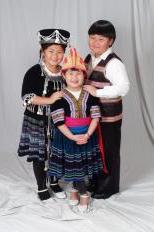






This is the first story in a two-part series about the traditions of Hmong-American residents in Madison. The annual Hmong New Year festival will take place Nov. 23 and 24 at the Alliant Energy Center.
 Hmong elders, Photo credit: Peng HerIn the Mendota Health Center conference room, an elderly Hmong woman in traditional clothing took command with a song about the New Year. Her voice jumped octaves and landed on punctuated phrases, like the Hmong flute music that followed.
Hmong elders, Photo credit: Peng HerIn the Mendota Health Center conference room, an elderly Hmong woman in traditional clothing took command with a song about the New Year. Her voice jumped octaves and landed on punctuated phrases, like the Hmong flute music that followed.
While elders in the Hmong community may be familiar with these musical crafts, their grandchildren growing up in Wisconsin have fewer opportunities to learn. Yet, both children and adults dressed up for the traditional New Year celebration.
At the 2011 New Years event at the Kajsaib house, the Hmong center within the Mendota Health System, more than 20 Hmong elders wore innately decorated costumes. Women showcased colorful skirts and prominent hats, while men donned vests clad with French coins. The annual event took place this year at the Kajsiab House on Friday, Nov. 15.
“Once a year you have to show off,” said Pao Yang, co-host of Hmong Radio on WORT-fm. “It’s once-a-year clothes [sic]....Hmong clothes.”
The Hmong population in the U.S. exceeds 250,000, with the largest groups in California, Minnesota, and Wisconsin. The Hmong population in Wisconsin grew more than 39 percent in the last decade to about 47,000.
As the local Hmong population continues to increase, younger generations grow up surrounded by U.S. cultural norms. Parents have to make a special effort to balance both cultural identities within their families, a challenge that affects the entire community.
At the Kajsaib House last fall, Dane Country Executive Joe Parisi made a point to commemorate pockets of diversity in Dane county.
“I’m particularly inspired by your commitment to maintaining your cultural identity,” Parisi said to guests.
The Kajsaib House serves as a cultural safe-haven for Hmong elders dealing with the negative side effects of the Vietnam War and refugee experience, such as post-traumatic stress disorder. In 1975, the U.S. opened its borders to the Hmong, who faced persecution in their own country after aiding Americans in the war.
Youth also visit the center to participate in cultural activities. Because of low funding, however, many Hmong fine arts activities are no longer offered at the Kajsaib House. Mee Vang, a domestic violence advocate for Freedom Inc, had to enroll her kids in traditional cane flute lessons elsewhere.
Language is another important aspect of Hmong identity, but Vang struggles to make her four children speak Hmong at home.
“They’re losing it,” she said. “All my kids now, they speak Hmong and English, but not as fluent as English. I can see that it’s going to disappear within a couple years…. It’s hard.”
All four of Vang’s children learned Hmong from their grandparents who helped raise them through age five. The grandparents still speak Hmong with Vang’s kids, but once the kids started school, they lost motivation to continue learning their first language.
The median age among Hmong in the U.S. sits at 20-years-old, however, over 40 percent of the national Hmong population is less than 17-years-old. Parents of these teenagers have a hard time promoting Hmong literacy when only English is reinforced at school.
Peng Her, community activist and father of three, agrees that it’s difficult to encourage Hmong literacy. Even in kindergarten, his son faced harassment for speaking Hmong.
 Photo credit: Peng HerWhen his son seemed a bit down on himself one afternoon, Her asked what was wrong. His son said, “Speaking Hmong is not cool.”
Photo credit: Peng HerWhen his son seemed a bit down on himself one afternoon, Her asked what was wrong. His son said, “Speaking Hmong is not cool.”
“First of all, it’s a struggle just to have our kids speak Hmong at home, because they’re so inundated with their classmates, going to school. Sesame Street’s in English,” said Her. “They're much more willing to speak English than Hmong.”
As part of an outreach effort, Her and his wife teach Hmong language courses at their home. Their student body ranges from adult Hmong to children who are learning to read and write in their native tongue.
Her’s 9-year-old daughter, Nongnah Her, says that she sometimes has a hard time reading Hmong and finding the right words to communicate with her grandparents, who speak a limited amount of English. She seems quite certain that she will study Hmong in the future.
“Yeah, because it’s my culture and my family knows [it], and I’m part of my family,” she said. “My family is Hmong, so I want to stick in with them.”
|
|
|
Welcome to the Madison Commons, a website designed to provide news and information about all of Madison's neighborhoods and a crossroads for the discussion of community issues. The name comes from the idea of a village commons, a place for news, talk, debate, and some entertainment, too, that's open to everyone.
All rights reserved. Read more about the Madison Commons and its partners.

